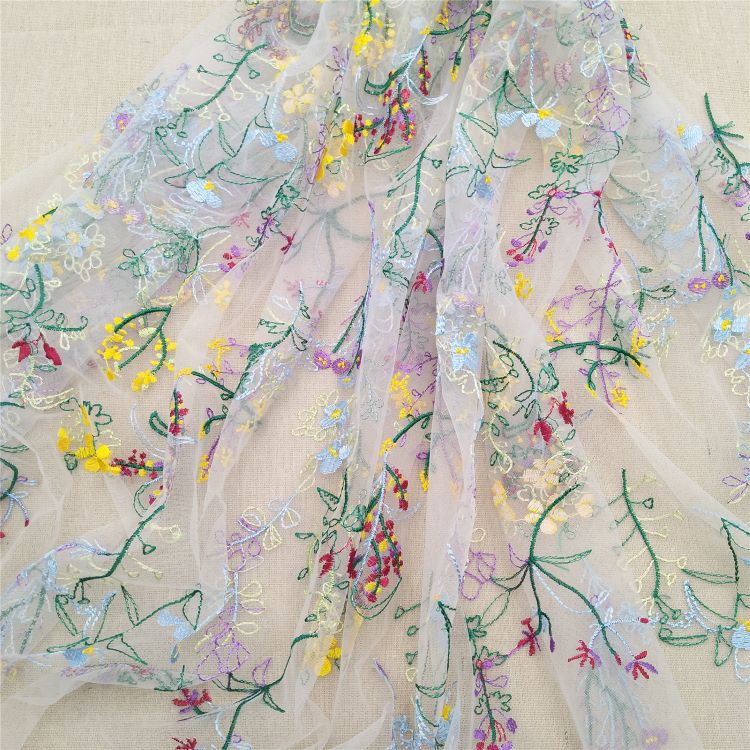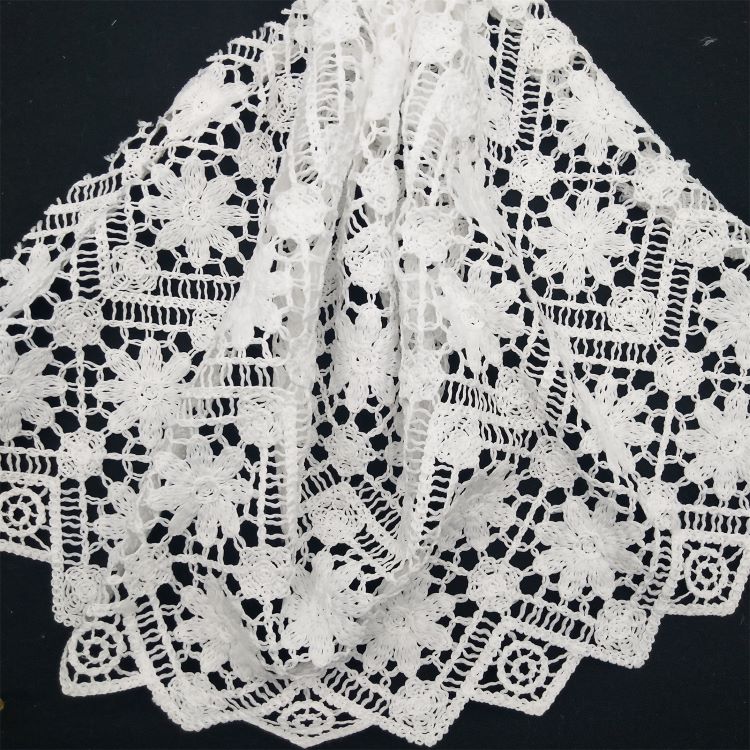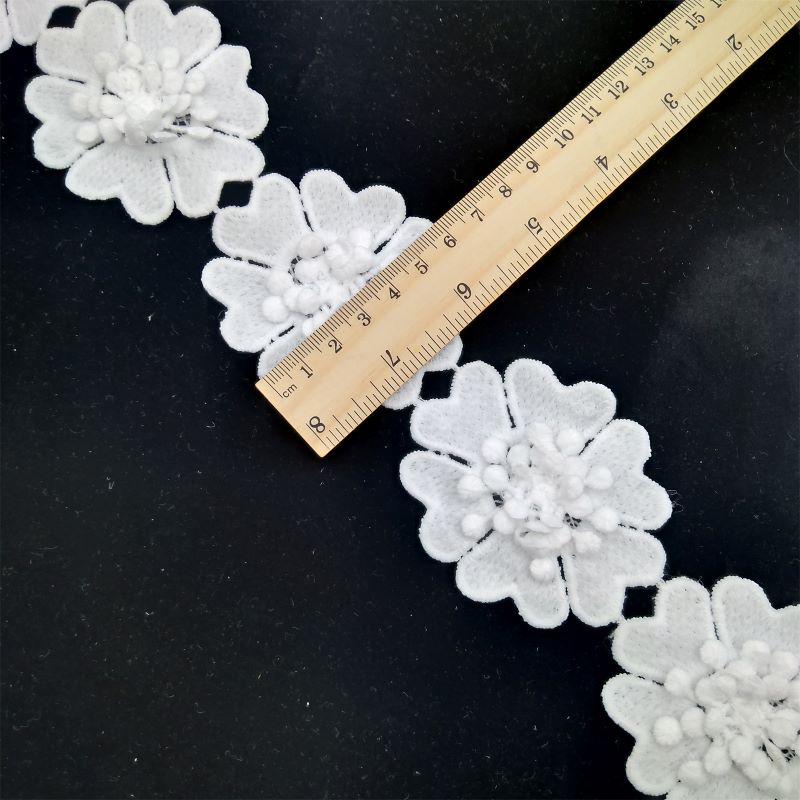Charming Chemical Embroidery: Why It’s Not as Scary as It Sounds!
We often get asked what is chemical embroidery? Because this is the most abstract category in embroidery, but chemical embroidery is used very often. I wanted to look for related content on the Internet, but after a few pages, even I, who have been doing this product for almost 20 years, didn’t understand what was said.
If we want to distinguish what is water-soluble embroidery, we must first figure out the classification of embroidery. We usually divide the most commonly used embroideries into three categories, and I’ll show you what the differences are.

Mesh embroidery

Cloth Embroidery

Chemical embroidery
The first one is made of mesh, so we call it mesh embroidery, the second one is made of cotton, so it’s called cotton embroidery, and the third one is made of water-soluble base cloth, but the water-soluble cloth goes through a water-soluble process during the production, so we can’t see the base cloth, which is chemical embroidery.
By this time, you should know about chemical embroidery. Embroidery requires a carrier in the production process, and chemical embroidery uses a water-soluble backing as the carrier. The production process and equipment are basically the same as the previous two embroidery categories. The process and equipment of chemical embroidery are basically the same as those of the previous two embroidery categories, except that there is an additional process of water solubility in the dyeing tank. After the water soluble process, our original embroidery pattern will be presented, which is full of fullness, three-dimensionality and drape.
The current equipment for the production of water-soluble lace is usually divided into two main types of what we commonly call.
1、Shuttle embroidery machine

Shuttle embroidery machines enable fast, cost-effective production of intricate chemical embroidery designs. Consistency is key: each piece is a perfect replication of the last, making it ideal for mass production without sacrificing quality.
2、Multi-head embroidery machine
Multi-head machines streamline chemical embroidery production, enabling rapid, simultaneous creation of identical, intricate designs. These machines ensure efficiency, uniformity, and high-quality output, making them a game-changer for mass manufacturing.And a set of patterns can be generated in up to 9 colors.

These two types of machines are the main production equipment for chemical embroidery, and the backing fabric laid on the machine is the water-soluble backing fabric before water-soluble.
The most important feature of chemical embroidery is that it has the strongest three-dimensional sense, the best texture, and a wide variety of interspersed flower patterns. It can be said that if chemical embroidery is done well, the price can be uncapped. High-quality chemical embroidery is often chosen by many big brands. A good chemical embroidery does not depend on how thick it is, but mainly on how fine the thread is used and how it makes a very three-dimensional feeling, with a very dense needle in thick places and a fine needle in fine places. It is necessary to add very dense stitches in thick places and fine stitches in thin places.




What are the main raw materials currently used in chemical embroidery?
1、cotton

Cotton, the star of natural fibers, shines bright with an array of advantages. It’s beloved for its softness, offering a supremely comfortable feel. Cotton’s breathability ensures excellent air circulation, enhancing wearer comfort by regulating body temperature. Additionally, cotton is durable, capable of withstanding wear and tear. It’s machine-washable and easy to care for, adding to its practical appeal. Plus, as a sustainable, renewable resource, cotton supports an environmentally-conscious approach in textiles.
Ah, the timeless elegance of all-cotton! When it comes to producing chemical embroidery, choosing all-cotton as your star material comes with a host of benefits that blend functionality with a classy aesthetic.
To start, cotton’s natural softness provides an unrivaled touch and feel that’s just dreamy against the skin. In chemical embroidery, the balance between durability and comfort is key, and cotton perfectly straddles this line. Imagine creating intricate designs that not only look fabulous but also provide a soft, comfortable touch to the wearer – it’s a win-win situation!
Secondly, let’s talk breathability. Cotton is known for its ability to allow for air circulation, reducing the risk of feeling too hot or stuffy when wearing it. When you create chemical embroidery on an all-cotton base, the end product not only looks spectacular, but also enhances the wearer’s comfort by regulating body temperature and moisture.
The durability of cotton is another significant plus. Cotton fibers have a natural tensile strength that makes them robust and long-lasting. When applied to chemical embroidery, the designs are not just visually striking, but they also stand the test of time.
Then, of course, we have to mention the ease of care. Cotton materials are generally machine-washable and easy to clean, making them a practical choice for everyday items. So, your beautiful chemical embroidery design won’t turn into a high-maintenance piece. Instead, it will be a piece of art that can withstand regular wear and washing.
Finally, let’s not forget sustainability. In an increasingly environmentally-conscious world, cotton – a natural, renewable, and biodegradable resource – certainly ticks the right boxes. When you produce chemical embroidery with all-cotton materials, you’re not just investing in quality and style; you’re also contributing to a more sustainable future.
In summary, the advantages of producing chemical embroidery with all-cotton are numerous. From its softness, breathability, durability, ease of care, to its eco-friendliness, cotton proves itself to be a reliable and versatile option for high-quality, beautiful chemical embroidery.
2、viscose
Viscose, often termed as ‘rayon’, boasts a rich, glossy sheen that imitates silk, enhancing the luxury of any fabric. Its excellent drape and soft touch add to its appeal. High absorbency allows vibrant dye uptake, ensuring lasting, brilliant colors. Plus, it’s relatively easy to care for!

Ah, viscose, the chameleon of the textile world! Known for its ability to mimic the qualities of various natural fibers, it brings its unique advantages to the world of chemical embroidery.
Let’s start with the shine. Viscose, or as it’s often called ‘rayon’, offers a brilliant sheen unmatched by many other fibers. This glossy appearance can give your chemical embroidery a luxurious look and feel, making it perfect for high-end fashion and home décor products. Imagine your designs taking on a new life, shimmering and dazzling in the light!
Then there’s the matter of drape. Viscose has an exceptional ability to drape well. This means when used in chemical embroidery, your end product will flow and fall beautifully, enhancing the embroidered design and adding an extra touch of elegance.
Viscose is also highly absorbent. While this may not sound glamorous, it does mean that it takes dye incredibly well. Your chemical embroidery will be vibrant and rich in color, and the colors will last longer without fading. This can turn your designs from great to truly extraordinary, providing an unforgettable visual experience.
Let’s not forget that viscose is soft. Really soft. Think of the kind of softness that makes you want to keep touching a fabric – that’s viscose. When used in chemical embroidery, it ensures the end product is not only gorgeous to look at, but also delightfully comfortable to wear or use.
Lastly, viscose is relatively easy to care for. It can generally withstand machine washing and doesn’t wrinkle easily. This means your chemical embroidery products will not only look stunning, but they’ll also be practical and user-friendly.
All in all, when it comes to producing chemical embroidery, using viscose offers an array of advantages. Its shine, drape, color absorption, softness, and ease of care all contribute to creating chemical embroidery that is not just visually stunning but also practical and enjoyable to use. Talk about the perfect blend of beauty and functionality!
3、polyester

Polyester’s advantages are myriad: it’s highly durable, wrinkle and shrink-resistant, and maintains its color vibrancy over time. It’s also quick-drying and resistant to most chemicals. Plus, being a cost-effective option, it offers style within budget!
because we’re taking a ride into the world of polyester, one of the most versatile and dynamic fibers used in chemical embroidery!
Starting with the most notable, polyester is renowned for its incredible durability. This synthetic fiber has a natural resistance to wrinkles and shrinking, meaning your stunning chemical embroidery designs will remain intact and unchanged, even after multiple washes and extensive wear. Imagine your designs keeping their perfect shape and form, never surrendering to the hands of time!
But that’s not all! Polyester is also impressively resistant to most chemicals. This makes it an ideal choice for chemical embroidery, as the fabric remains largely unaffected during the embroidery process, ensuring a beautifully consistent end result.
Another brilliant benefit of polyester is its quick-drying nature. When used in chemical embroidery, this translates into products that are not only easy to wash, but also easy to dry, adding to their practicality. Who doesn’t love a gorgeous piece of embroidery that requires minimal care?
Let’s not forget about color retention. Polyester holds dye extremely well, maintaining its vibrancy for a very long time. When used in chemical embroidery, this means your designs will stay brilliantly colorful, wash after wash. This is particularly beneficial for bold and vibrant designs that are intended to make a statement.
Lastly, polyester is a cost-effective option. Given its synthetic nature, it’s generally more affordable than many natural fibers. Therefore, producing chemical embroidery from polyester allows you to create stunning designs without breaking the bank. This also opens up the possibility for more people to enjoy your beautiful embroidery creations, making beauty and style accessible to all.
In summary, the use of polyester in chemical embroidery comes with a plethora of benefits. From its durability, chemical resistance, quick-drying nature, color retention, to its cost-effectiveness, polyester proves to be a practical and efficient choice for stunning and enduring chemical embroidery. This synthetic fiber truly is a real-life superhero in the textile world!
Different raw materials have their own characteristics, so we will share the usage of raw materials in embroidery and lace next time.
Let’s talk about the main uses of chemical embroidery



I hope this issue on chemical embroidery is helpful, contact us if you’re interested and let’s talk!
Chemical embroidery, also known as water-soluble embroidery or solvent-based embroidery, is an innovative technique that has gained recognition in the field of textile design. With my expertise and twenty years of experience as a chemical embroidery specialist, I am pleased to offer an expanded interpretation of this fascinating process. Chemical embroidery involves the use of embroidery thread to create intricate and vibrant patterns on chemical fabrics. Unlike traditional embroidery techniques, which rely on needle and thread, chemical embroidery uses a solvent-based backing fabric. The backing fabric naturally dissolves when it encounters water during the production process, leaving only the highly three-dimensional embroidery pattern. As the fabric dissolves in water, if dyes are added, the dye colors follow the seams of the dissolved backing fabric and are placed deep into the embroidery, allowing them to penetrate and bond with the fabric fibers. This chemical reaction produces vibrant, long-lasting colors that are deeply embedded in the fabric. Chemical embroidery offers a wide range of creative possibilities. The use of different solvents and pigments allows the artist to achieve a variety of effects such as gradients, textures, and even three-dimensional designs. As an experienced chemical embroidery specialist, I have witnessed the continuous evolution of this technique with advances in materials, solvents and application methods. The fusion of chemical and textile arts has opened up new avenues of creativity and expression, pushing the boundaries of traditional embroidery techniques. In short, chemical embroidery is a fascinating form of textile decoration. Its three-dimensionality, durability and ability to produce vibrant colors make it a popular choice for artists, designers and hobbyists alike. The future of chemical embroidery holds exciting possibilities as it continues to evolve and inspire new dimensions of artistic expression in the textile world
FAQs
- Q: What is chemical embroidery?
A: Chemical embroidery is an innovative technique that involves the use of embroidery thread to create intricate and vivid designs on chemical fiber fabrics. Instead of using needles and thread as in traditional embroidery, chemical embroidery uses a solvent-based backing. - Q: How is chemical embroidery different from traditional embroidery techniques?
A: Unlike traditional embroidery techniques that rely on needles and thread, chemical embroidery uses a solvent-based backing. During the production process, this backing naturally dissolves when exposed to water, leaving behind a three-dimensional embroidery design. - Q: What happens when the backing fabric dissolves in water?
A: When the backing fabric dissolves in water, if dyes are added, the dye colors penetrate deeper into the embroidery along the seams of the dissolved backing fabric. This allows them to penetrate and bond with the fabric fibers, creating a vibrant, long-lasting color. - Q: How do the colors in chemical embroidery compare to traditional embroidery?
A: In chemical embroidery, the colors are vibrant and long-lasting because they are deeply embedded in the fabric. This is a result of the dye penetrating and bonding with the fabric fibers when the solvent-based backing is dissolved in water. - Q: What types of effects can be achieved with chemical embroidery?
A: By using different solvents and pigments, the artist can achieve a variety of effects in chemical embroidery such as gradients, textures and even three-dimensional designs. - Q: How has chemical embroidery evolved over the years?
A: With advances in materials, solvents, and application methods, chemical embroidery has evolved significantly. It has moved beyond the limitations of traditional embroidery techniques, opening up new avenues of creativity and expression. - Q: What are the benefits of using chemical embroidery?
A: The benefits of chemical embroidery include its three-dimensionality, durability, and ability to produce vibrant colors. It’s a popular choice for artists, designers, and amateurs because of these qualities. - Q: Is chemical embroidery considered a form of textile decoration?
A: Yes, chemical embroidery is a fascinating form of textile decoration that has gained recognition in the field of textile design. - Q: How does the use of different solvents impact the design in chemical embroidery?
A: The use of different solvents can influence the effects achieved in the embroidery. They can help create various gradients, textures, and even three-dimensional designs. - Q: How do dyes play a role in chemical embroidery?
A: Dyes are crucial in chemical embroidery. When the backing fabric is dissolved in water, the added dyes penetrate deeply into the embroidery, bonding with the fabric fibers. This results in vibrant, long-lasting colors. - Q: What materials are used in chemical embroidery?
A: Chemical embroidery uses embroidery thread and a solvent-based backing on chemical fiber fabrics. - Q: What is the role of the solvent-based backing in chemical embroidery?
A: The solvent-based backing plays a crucial role in the creation of the embroidery design. When exposed to water, it dissolves, leaving behind the embroidery design. - Q: Is the color from chemical embroidery durable?
A: Yes, the colors produced by chemical embroidery are durable because they penetrate and bond with the fabric fibers, making them long-lasting. - Q: Can chemical embroidery be used for creating three-dimensional designs?
A: Yes, chemical embroidery can create three-dimensional designs, thanks to the use of a solvent-based backing that leaves behind a three-dimensional pattern when dissolved. - Q: Is chemical embroidery popular in the art and design world?
A: Yes, because of its three-dimensionality, durability, and ability to produce vibrant colors, chemical embroidery is a popular choice among artists, designers, and amateurs. - Q: Can chemical embroidery be used on any type of fabric?
A: Chemical embroidery is typically done on chemical fiber fabrics. - Q: What’s the future of chemical embroidery?
A: The future of chemical embroidery is full of exciting possibilities. As it continues to evolve, it is inspiring new forms of artistic expression in the textile world. - Q: Can chemical embroidery produce gradients?
A: Yes, by using different solvents and pigments, it’s possible to create gradients in chemical embroidery. - Q: Can chemical embroidery be done by amateurs?
A: Yes, chemical embroidery can be done by amateurs, making it a popular choice among various groups of people interested in textile decoration. - Q: How does the use of different pigments affect the design in chemical embroidery?
A: The use of different pigments can impact the colors and visual effects achieved in the embroidery, allowing for a variety of creative possibilities.


